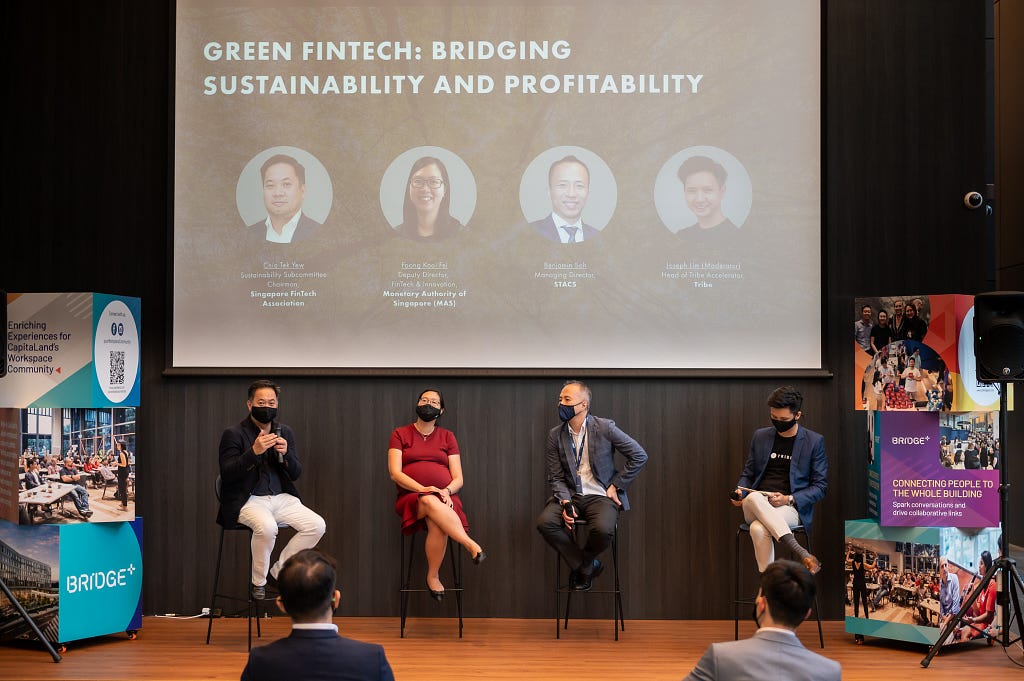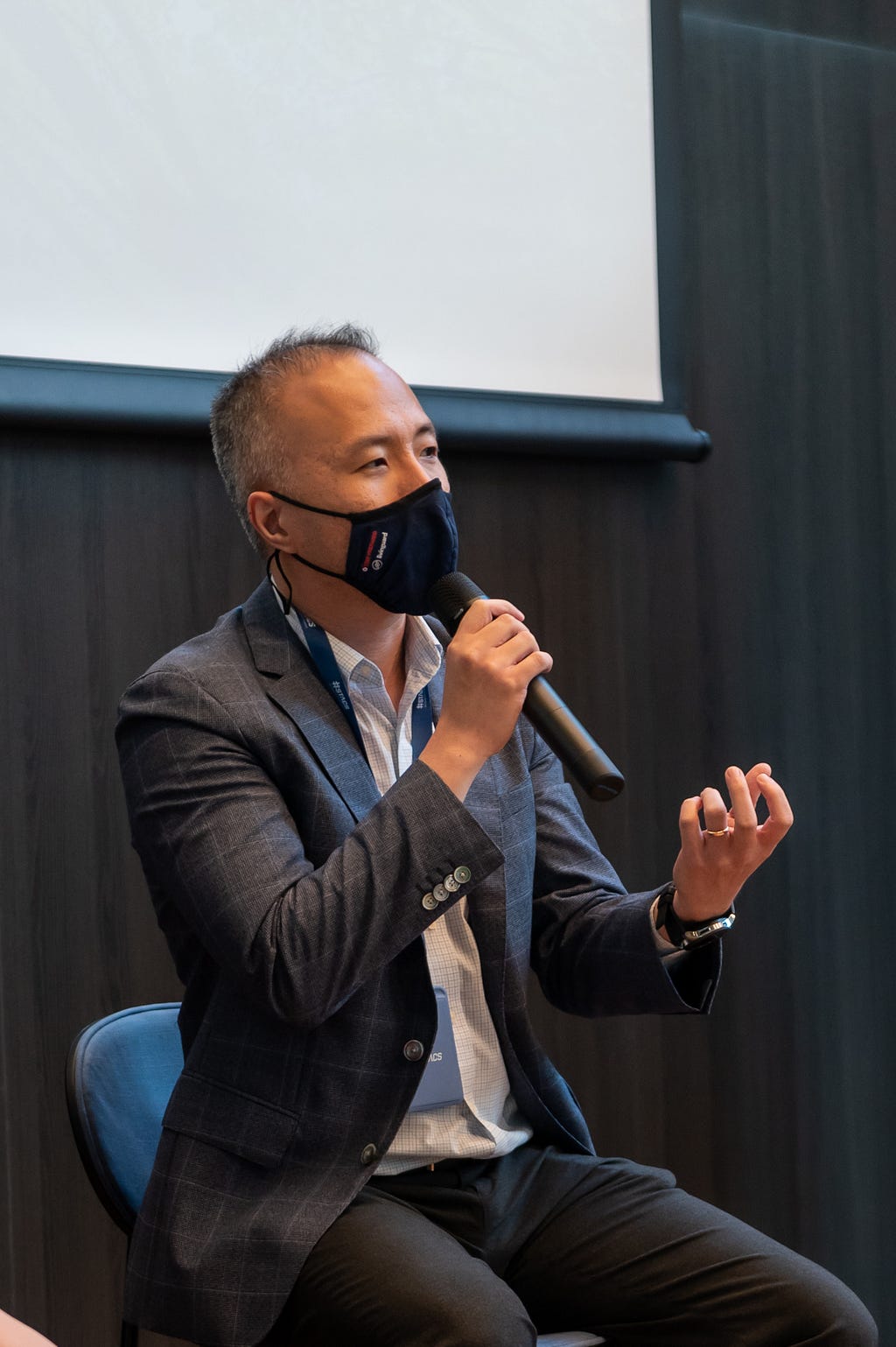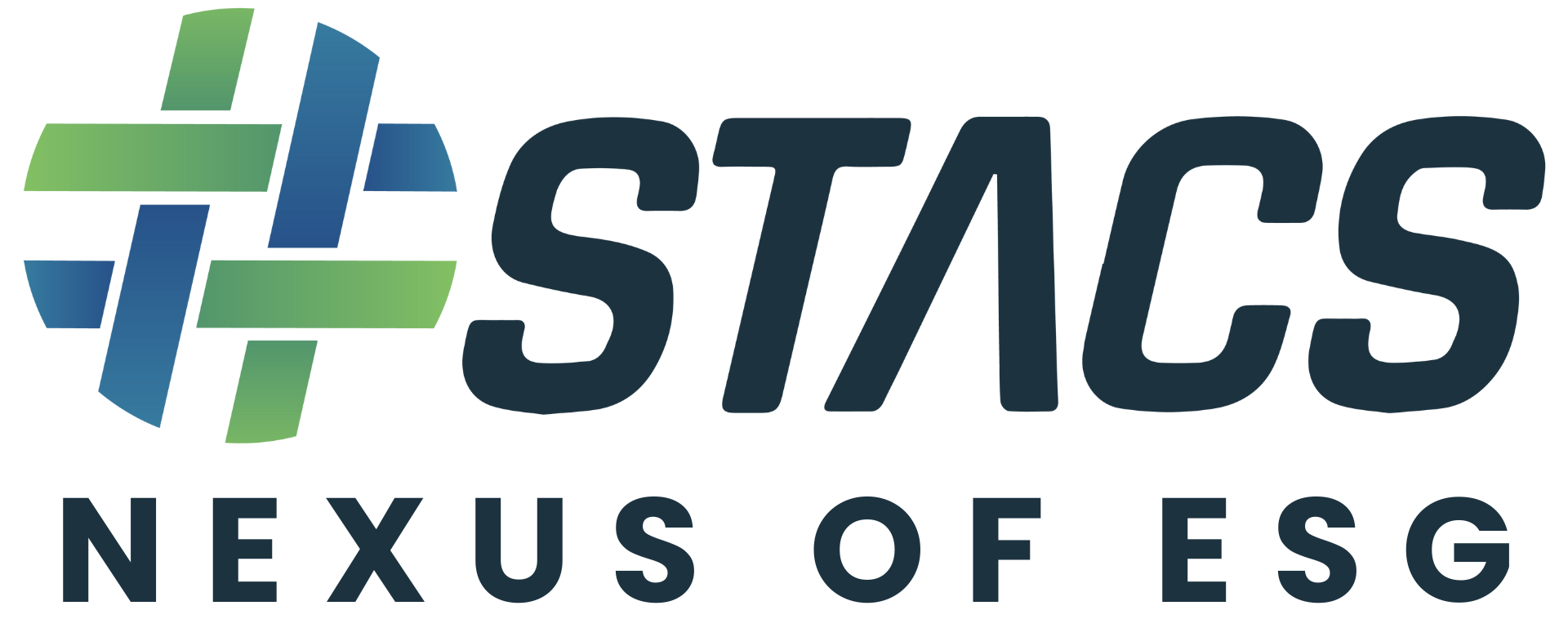
GREEN FINTECH: BRIDGING SUSTAINABILITY AND PROFITABILITY
In celebration of Earth Day 2021, STACS co-hosted a Green FinTech panel at Bridge+ 79 Robinson Road in partnership with Tribe Accelerator, Alibaba Cloud, and enabled by flexible workspace Bridge+ by CapitaLand. Headline issues discussed in the nearly hour-long panel on 21 April 2021 include macro trends in green finance and fintech, as well as key stakeholders in the emerging category and the need to balance sustainability goals alongside corporate profitability.

Participating in the Earth Day-themed panel was our very own Benjamin Soh, Co-founder & Managing Director at STACS, as well as Kooi Fei Foong, Deputy Director of the Fintech and Innovation Group at the Monetary Authority of Singapore (MAS), Joseph Lim, Head of Tribe Accelerator, and Chia Tek Yew, Chairman of the Sustainability Subcommittee at Singapore Fintech Association (SFA).

Joseph, the moderator of the session, set the stage by addressing how organisations can further push the convergence of environmental, social, and governance (ESG) financial services and technology to drive a more positive impact on the environment. He welcomed comments through the lenses of each panellist: be it as a technology provider, regulator, or ecosystem player.
Responsibility to be green
Diving into some of the macros trends around the acceptance of fintech in ESG and how the attitude of the market has changed over the last couple of years, Ben opened with some initial observations on the lay of the land: “In the last few years, we do see a macro trend towards green fintech as a partnership between tech companies and financial institutions.”

“There is more focus on ESG right now, and banks are realising they have a responsibility — fairly or unfairly — to be able to help in tracking the greenness of a given project. There is a lot more that technology can enable, including greater democratisation of finance and improving access. But the greatest impact is only possible through us as a tech platform partnering with the existing financial institutions, which already have millions of users. This collaboration is vital to enable green sustainability in finance,” Ben added.

Kooi Fei explained that green fintech is a new buzzword, similar to what fintech was five years ago when the industry saw the opportunity for technology companies to play a more important role in the financial sector. This included areas like reducing costs, improving efficiencies, and enabling greater access. “Today, green fintech is really about the role technology can play as we push towards a global green finance agenda,” she said.
“The regulator plays an important role because we look at things like disclosures and reporting. Banks have to report to MAS so that we can do an overall assessment of financial stability with regards to environmental or climate risks. But we’re also focused on how to attract green finance to Singapore and how to develop ourselves as a leading green finance centre or hub, specifically with regards to green fintech,” Kooi Fei said.
Encouraging the industry to collaborate or pilot technology solutions to solve some of the major problem statements of the finance industry remains an important mandate for the regulator.
“Obviously there are risks and companies have to balance sustainability versus profitability. That’s where we can come in by providing grants and co-funding projects, whether it’s POCs (proof of concepts) or actual implementations. We’re trying to create opportunities for all stakeholders to think outside the box in terms of how they can adopt new technologies, such as IoT (Internet of Things), to better monitor and track the performance of a green project, bond or loan,” she added.
Making green measurable and verifiable

Tek Yew believes that in the same way fintech companies contributed to addressing problems of financial inclusion for SMEs and underserved communities in the past decade, they have now similarly set their sights on helping financial institutions transition to more green operations. Even something like the funding of solar panels on a small factory can be made more affordable and accessible through new technology that fintechs are building.
“Whether it’s on the data side, whether it’s in blockchain, or whether it’s using IoT to measure and verify that data, fintechs are figuring out how to apply it to green use cases,” he said. “When you talk about sustainability, the stakeholders are very wide. It’s not just the banks, it’s also the investment companies, the sovereign wealth funds, every foundation, family office, and next generation wealth manager. They are all looking into green finance solutions.”
“And then there is the investor financing component, as well as implications for insurance. You see regulators talk a lot about climate risks, but you now also see the corporates doing the same. Even the most profitable companies in the world, who don’t need to do any of this in order to become more profitable, are still looking at their environmental commitments and responsibilities. So we’re seeing both demand and supply in high volumes on the green finance agenda,” he added.
For Tek Yew, the most pressing questions become: how can technology, specifically fintech, make this whole process easier for everyone? How can we make the selection, measurement, and verification processes streamlined so that the green finance activities are real and not just greenwashing? That’s precisely the challenge the current generation of fintechs — including STACS — are working to solve.
Reasons to be optimistic
As a serial entrepreneur now working on his second start-up, and with more than a decade of experience building fintech solutions for banks, asset managers, exchanges, and clearing houses, Ben believes there are many reasons to be optimistic about the future of green fintech.
“We’re seeing a lot more interest from the private sector coming in, driven by the leadership of our various sovereign wealth funds like Temasek, who just declared that they’re going to be 100 per cent green. Today’s VC (venture capital) funds, as well as younger business executives and investors, are demanding more ESG-friendly options for capital allocation. This trend can never be rolled back,” he said.
“Even the oil and gas companies are looking into sustainability and renewable forms of energy. These are all real facts and trends driven by private capital. So, I’m very optimistic about the future of green fintech in general… That’s why at STACS we want to be able to empower this next generation of financial infrastructure. We have already done some designs and testing, and I’m quite eager to showcase our latest technology over the coming weeks and months.”
You can watch the playback of the panel in full on our YouTube channel here. Do remember to also check out our new GreenSTACS platform, which is helping financial institutions become more transparent and accountable in terms of their sustainability agendas and achieve effective green and sustainability-linked loans and bonds.
About STACS
STACS (Hashstacs Pte Ltd) is a Singapore FinTech development company with a Vision to provide Transformative Technology for the Financial Industry, with its complete infrastructure of live institutional green and ESG-enabling platforms that make global markets simpler. STACS is leading the way forward by digitalizing assets, processes, and documents using its patent-pending STACS Blockchain technology. Its clients and partners include global banks, national stock exchanges, and asset managers. STACS is The Asset Triple A Digital Awards 2021 FinTech Startup of the Year, an Award Winner of the Monetary Authority of Singapore (MAS) Global FinTech Innovation Challenge Awards 2020, and a two-times awardee of the Financial Sector Technology and Innovation (FSTI) Proof of Concept (POC) grant, under the Financial Sector Development Fund administered by MAS. STACS aims to empower financial institutions to unlock massive value and discover new opportunities through our technology.
For Enquiries
[email protected]
Website
www.stacs.io




